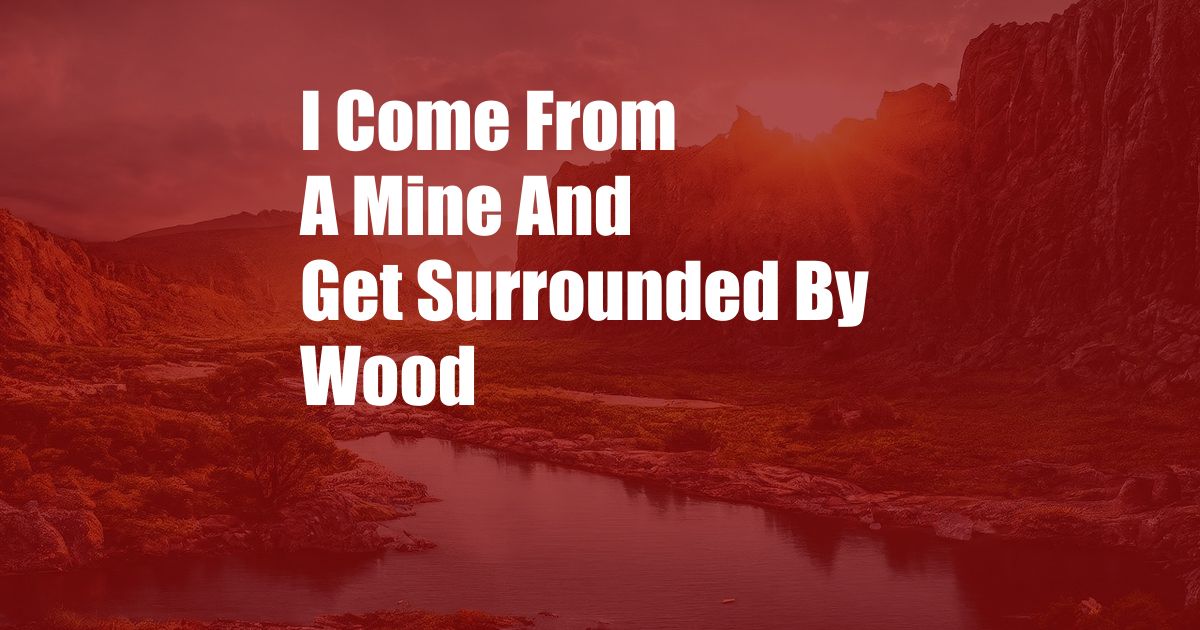
I Come From a Mine and Get Surrounded by Wood: A Journey of Discovery
When I first heard the phrase “I come from a mine and get surrounded by wood,” it instantly sparked my curiosity. It seemed like a riddle or a cryptic message, and I couldn’t resist the urge to unravel its meaning. As I delved deeper into the subject, I discovered a fascinating world of materials, their origins, and the remarkable transformations they undergo to serve our daily needs.
The Origins of Pencil Lead: A Journey from Graphite to Wood
The seemingly simple pencil lead, a ubiquitous tool in our lives, has an intriguing origin story. It begins in the depths of the earth, where graphite, its core component, is found in mines. Graphite is a naturally occurring mineral composed of carbon atoms arranged in a hexagonal lattice structure. This unique structure gives graphite its characteristic soft and slippery properties, making it an ideal material for writing and drawing.
Once extracted from the mine, graphite is processed and refined to remove impurities and improve its quality. It is then mixed with clay, a natural binder that helps hold the graphite together. This mixture is then extruded into thin rods, which are later cut into the familiar cylindrical shape of pencil leads.
Embracing the Wood: Encasing the Lead for Writing and Drawing
The defining characteristic of a pencil is its protective wooden casing. This casing serves multiple purposes: it protects the delicate graphite lead from breakage, provides a comfortable grip for writing, and offers a surface for erasing errors. The wood used for pencil casings typically comes from cedar or basswood trees, known for their softness, straight grain, and resistance to warping.
The process of encasing the lead in wood involves precision machinery. Thin planks of wood are cut and grooved to form the pencil’s shape. The graphite leads are then inserted into the grooves, and the two halves of the pencil are joined together. The finished pencils are sanded, painted, and stamped with branding and other information.
A Symphony of Materials: Combining Graphite and Wood for Versatility
The combination of graphite and wood in a pencil creates a versatile tool that has stood the test of time. Graphite provides the ability to make dark, easily erasable marks, while wood offers protection and durability. Pencils have become indispensable tools for artists, writers, students, and countless others, serving a wide range of purposes from sketching and drawing to writing and note-taking.
The versatility of pencils is further enhanced by variations in lead hardness. Pencils are graded on a scale from 9H to 6B, with 9H being the hardest and 6B the softest. The hardness of the lead determines the darkness and erasability of the marks it produces. Harder leads create lighter, more precise marks, while softer leads produce darker, more easily erased marks.
Evolutionary Trends and Developments in Pencil Design
While the basic design of a pencil has remained relatively unchanged for centuries, advancements in materials and manufacturing techniques have led to the development of innovative pencils. These include mechanical pencils that allow for precise lead advancement, erasable pencils that use heat-sensitive ink, and water-soluble pencils that can be used for painting.
In addition, the use of sustainable materials in pencil production has become increasingly important. Pencil manufacturers are exploring the use of recycled wood, biodegradable plastics, and other environmentally friendly materials to reduce their impact on the planet.
Expert Tips and Advice for Pencil Enthusiasts
As an avid pencil user myself, I’ve accumulated a wealth of knowledge and tips over the years. Here are a few pieces of advice to enhance your pencil-using experience:
-
Choose the right hardness: Experiment with different pencil grades to find the ones that best suit your writing or drawing style.
-
Sharpen regularly: A sharp pencil will produce clean, precise lines, so make sure to sharpen it frequently.
-
Use a light touch: Pencils can easily press too hard, so try to hold them lightly and let the lead do the work.
-
Explore different techniques: Pencils can be used for a variety of techniques, including sketching, shading, and cross-hatching. Experiment with different techniques to find what you enjoy most.
-
Embrace the eraser: Don’t be afraid to erase mistakes or experiment with different effects. Erasers are an essential part of the pencil experience.
Frequently Asked Questions About Pencils
Q: What is the difference between graphite and charcoal pencils?
A: Graphite pencils are made from a mixture of graphite and clay, while charcoal pencils are made from pure charcoal. Charcoal pencils produce darker, more expressive marks, but they are also more difficult to erase.
Q: How can I choose the right pencil for my purpose?
A: Consider the hardness of the lead and the type of writing or drawing you’ll be doing. For sketching and general writing, a medium-hardness pencil like HB or F is a good starting point.
Q: What is the proper way to sharpen a pencil?
A: Use a sharpener that is specifically designed for pencils. Hold the pencil perpendicular to the sharpener and apply gentle pressure while rotating it.
Q: Are pencils toxic?
A: Pencils are generally non-toxic, but it’s important to avoid ingesting large amounts of graphite or lead.
Conclusion
The humble pencil, a seemingly simple tool, is a testament to the ingenuity and creativity of humankind. Its journey from the depths of a mine to the protective embrace of wood speaks volumes about the transformative power of materials. Whether you’re an artist, a writer, or simply an everyday user, pencils remain an indispensable part of our creative and communicative endeavors.
So, the next time you pick up a pencil, take a moment to appreciate the remarkable story behind its creation. Embark on a journey of discovery, embrace the versatility of graphite and wood, and let your imagination soar.
Are you fascinated by the world of pencils and their origins?